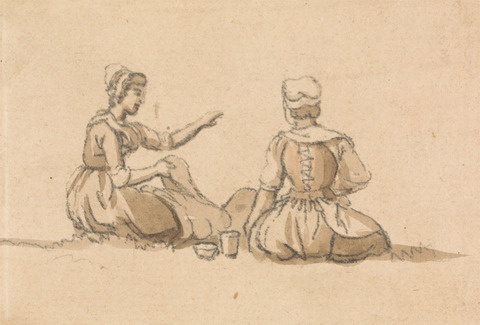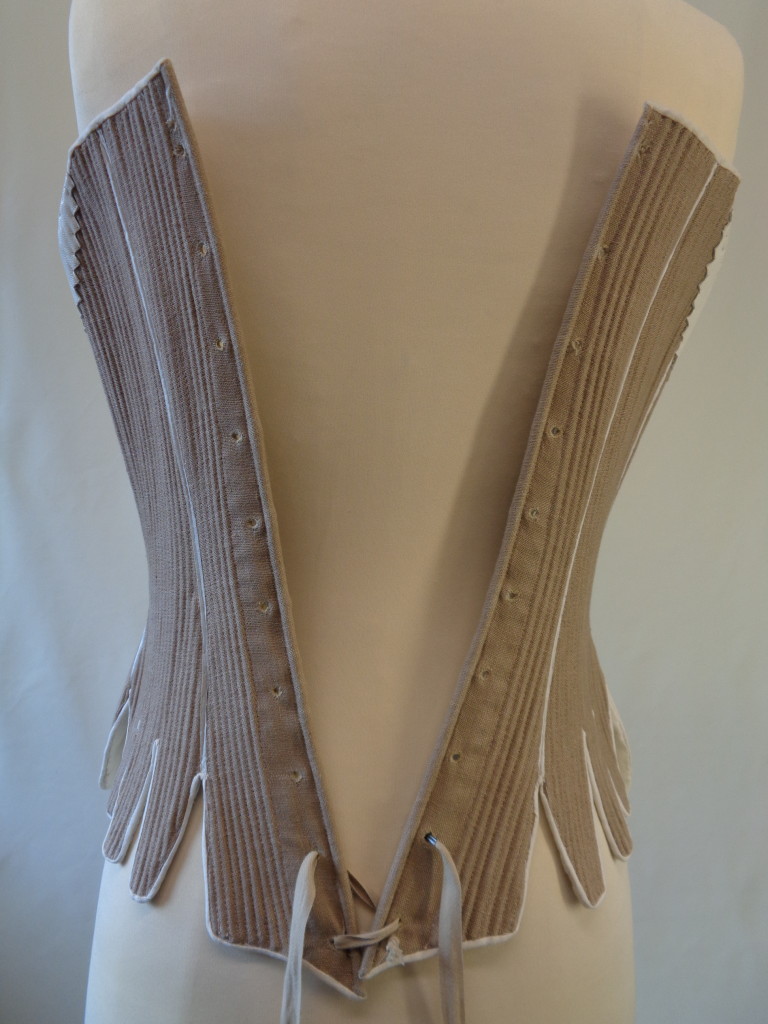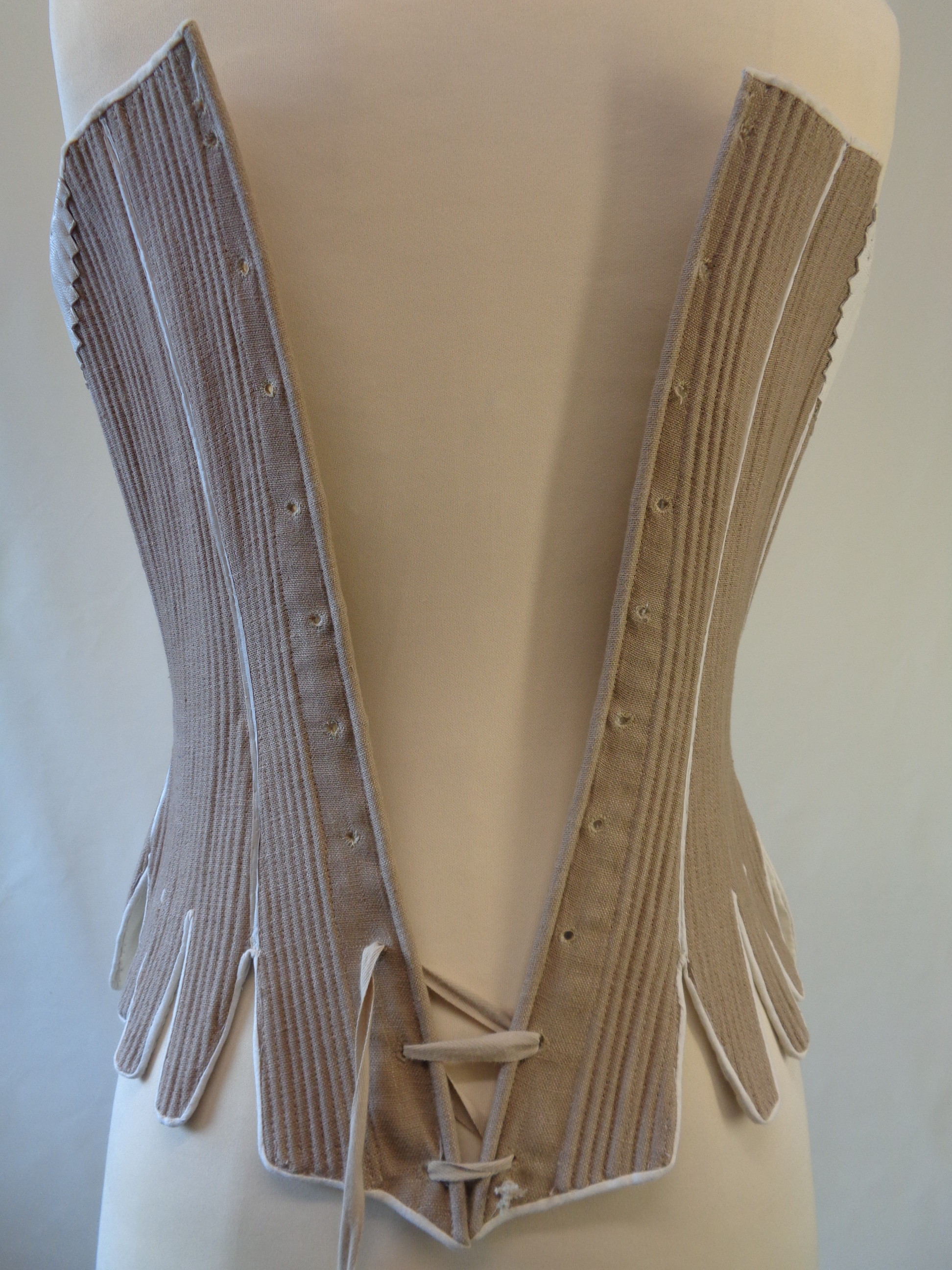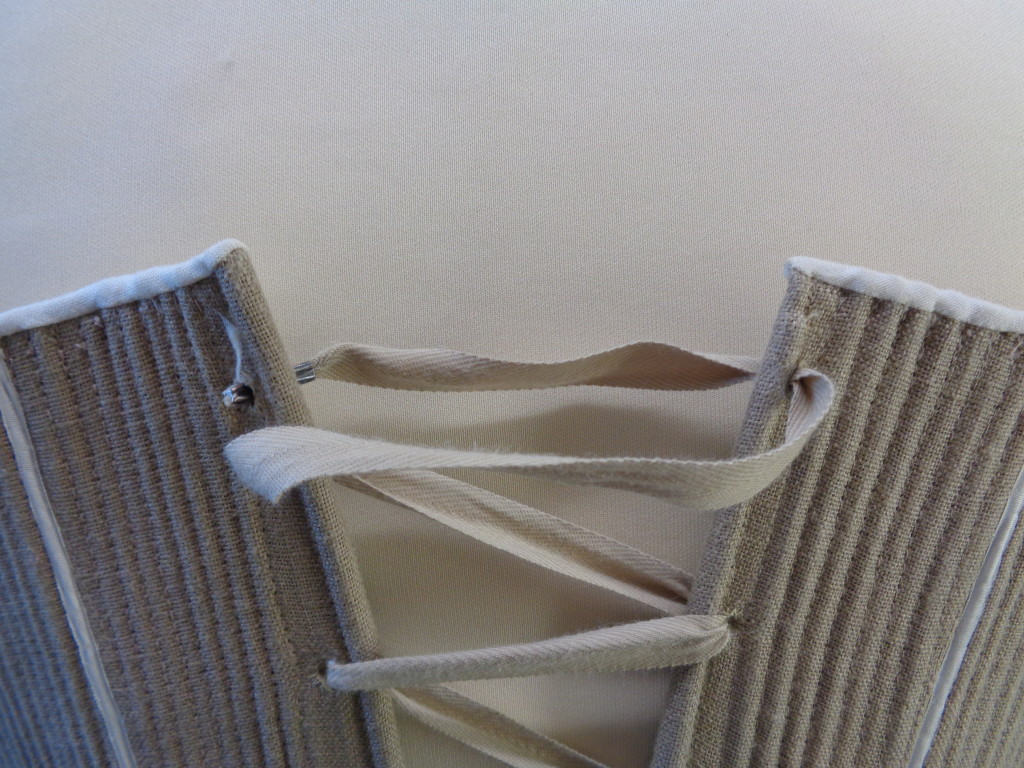Straight Lacing
The Essential ‘How to…’
On this page we should lead you through a step-by-step, photo journey of how to lace your Stays using the ‘Straight Laced’ Method.
There seems to be a lot of History surrounding this term and we will confess that we have not yet gotten round to researching it
more deeply – you may well be having to wait a little longer for the ‘How to’ page if we did that. However we all know the term ‘Straight Laced’, a phrase that we can use to describe someone who has strict morals, It seems to be virtually certain that this phrase links back to this form of lacing but whether or not it links to the 18th century period is unclear. It certainly seems to be the most used lacing method of the Museums, Paul Sandby sketches it being used in many of his images, working women and wealthy, many of the later 18th c Stays in the museums that have that the half opening CF section use a Straight Lacing method with the rich ribbons and this mostly seems to have been untouched since there time of origin. Also, the staggered lacing holes that we have seen on virtually all of the Stays we’ve studied (we can’t think of any that didn’t!) are needed for the way you lace when doing it Straight. All, in all this points to Straight Lacing probably being the most popular and standard way of lacing one’s Stays up.
There also seems to be a variation of Straight Lacing where the eyelets are not directionally opposite one another but are staggered all the way up which creates a zig-zag effect rather than a ladder. This is exactly the same technique as Straight Lacing and will be dependant on the position of the eyelets on your stays.
So, How to Start:
1) You will need a Length of ribbon with a knot at the one end and either an awl to be able to push the other end through the ho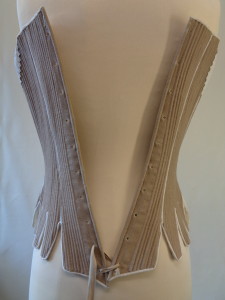 les or an aiglet/metal tip fixed to the end. The length of ribbon will totally depend on the style of stays, the cut of them and how tight they are to be worn. Generally though a metre and a quarter (1.25cm or 50″) to about one and a half is plenty (1.50mts or 60″)
les or an aiglet/metal tip fixed to the end. The length of ribbon will totally depend on the style of stays, the cut of them and how tight they are to be worn. Generally though a metre and a quarter (1.25cm or 50″) to about one and a half is plenty (1.50mts or 60″)
- Push the unknotted end (from this point forth called the ‘Tipped End’) through the Lower Staggered Eyelet, coming from the topside and in through to the under side.
- Pull the ribbon all the way through so that the knot sits on the top of the Lower Staggered Eyelet.
- Now pull the Tipped End over to the opposite eyelet on the other side and COME UP from the underside to the top. Pull the ribbon through.
- Now push the Tipped End DOWN through the Upper Staggered Eyelet, from the topside to the underside.
This is the Staggered Eyelet Section.
- Next bring the Tipped End to the other side of the opening to the opposite eyelet and COME UP through from the underside.
- Now bring the Tipped End to the opposite eyelet and go DOWN from the topside to the underside. Pull the lace through without making it massively tight.
- What we’ve done here is the standard lacing method and you are just going to repeat the as you work your way up the lacing section. COMING UP on the one side, going over to meet the matching opposite eyelet and the going DOWN through to the underside.
- The next following photographs show this in action.
You can begin to see how the lacing works and why it is called Straight Lacing – the ladder like effect creates that straight bar that comes over the top of the CB opening.
- Continue up the back in this way until you get to the top and the second Staggered Eyelet section. Here you need to push up through the Lower Staggered eyelet as is your next natural step anyway. Then you COME OVER the top to the opposite eyelet and go DOWN through that hole as normal.
- Then you push the Tipped End UP through from the underside.
- Next comes the tightening. Work your way up or down the body, depending on what you fancy. But make sure you are pulling the lacing away from the body in a downward motion, not just out nor up. As you tighten, work the ribbons back up through the eyelets pulling it out at the top. Tighten til comfortable or you have reached the desired measurements. You will find, as you get used to wearing Stays, the most comfortable way to wear them for you. We’ve found a couple of things for us work – it sounds strange but we find that lacing ourselves in gets the most comfortable fit, we think there’s something in the motion the hand pulls the laces when you do it yourself that works better. We also find that the waist can take a lot more reducing without restriction. We often wear out stays with them cinched tightly at the waist but the bust and rib area not laced so fully. The cone like shape is still being created and it has the added bonus of not altering the way the lungs move so much,
- And the last stage is tying off. There are two methods that seem to mostly get used. If you are doing it yourself, we find the following technique the easiest to do with the one hand and we have not had a problem undoing it at the end of the day yet.
- Pull the Tipped End out through the last hole and pull the rest of the length of ribbon now unused through. Tuck this end of ribbon over the top of this top ladder-bar of lace but leaving a gap between that and the eyelet. Next tucked the remaining lace in this loop between the eyelet and the bit you’ve just tucked over the top laced bit so that you create a half knot. Pull it tight and slide it near to the eyelet. Let the rest of the ribbon hang down.
- If you have laced yourself in, you will have a very long bit of lace left to hang down. If this is the case we find it useful to roll it up into a ball and tuck it into our pockets. If you’re not wearing pockets then you can just tuck it under a tab or under your petticoat ties but it can have a habit of suddenly falling out and you find yourself trailing ribbon.
We hope you now understand how to lace your stays using the Straight Laced Method. This description can be applied to if you are lacing yourself in and are just preparing the stays for being pulled over the head (in which case you will need a much longer length of ribbon and to leave the gaps between the eyelets wide enough to pull on over your head) OR, if someone is lacing you in. Whichever way, before you begin to tighten, make sure the stays are sitting in the right position on your body: that the CF line is correct and the waistline (if your stays have one) is in the right place.
DO NOT move your Stays once they are tightened! If something doesn’t feel right then just loosen and re-organise yourself – we often find we’ve not held our shift down properly for example BUT please do not just pull on your shift or wiggle your stays into a better position. You will make yourself more uncomfortable as the stays tightened are pressing into your torso and can twist skin and general inside organs. Be patient and undo and re-tighten.

